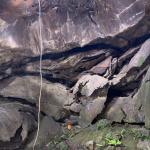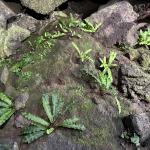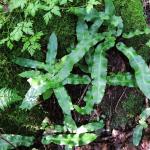Asplenium scolopendrium var. americanum (American hart's-tongue fern)
Phyllitis scolopendrium var. americana Fernald; Phyllitis japonicum ssp. americana (Fernald) Á. Löve & D. Löve
Stems erect, unbranched; scales brown, lanceolate, 3--6 × 1--1.5 mm, margins entire; leaves monomorphic; petiole brown to straw-colored, dull, 3--10 cm, 1/8--1/4 length of blade; indument of brown, narrowly lanceolate scales; blade linear, simple, 8--35 × 2--4.5 cm, thick, papery, nearly glabrous, base cordate, margins entire, apex acuminate, not rooting; rachis brown proximally, straw-colored distally, dull, glabrous; veins free, obscure; sori numerous, perpendicular to rachis, or nearly so, usually restricted to distal 1/2 of blade.
There are no similar ferns in New Mexico. All of our other ferns have compound, deeply lobed, or forked leaves, except Ophioglossum in which the vegetative leaves are elliptic to ovate, and only 1 or 2 are produced from a short subterranean stem.
New Mexico, Cibola County, from a single location at the El Malpais National Monument; in the U.S. from Alabama, Tennessee, Georgia, Michigan, New York; also known from Ontario, Canada.
In New Mexico, found on calcareous rocks in sinkholes, at cave entrances, and on cool, moist talus; always in deep shade.
The American variety was distinguished from the European plants on the basis of their smaller leaves, narrower scales with longer, attenuate tips, more promptly glabrate midribs, and blades tending to bear sori in the distal half rather than the entire length. Also, there are differences in perispore morphology of the two varieties. The most clear-cut difference is that the American plants are tetraploid and the European plants are diploid. More work is needed to determine if Asplenium scolopendrium var. lindenii (Hooker) Viane, Rasbach, & Reichstein, which occurs in southern Mexico (Oaxaca and Chiapas) and Hispaniola, is distinguishable from var. americanum.
In NM the only known population is located at the mouth of a cave. Potential impacts from cave visitors should be carefully monitored. Climate change may cause the current habitat in NM to become unsuitable in the future.
*USFWS. 2019. Species Status Assessment Report for the American Hart’s-tongue Fern (Asplenium scolopendrium var. americanum), Version 1.3. U.S. Fish and Wildlife Service, New York Field Office, Cortland, New York.
USFWS. 2020. American Hart’s-tongue Fern (Asplenium scolopendrium var. americanum). 5-Year Review: Summary and Evaluation. U.S. Fish and Wildlife Service, New York Field Office, Cortland, New York.
For distribution maps and more information, visit Natural Heritage New Mexico




